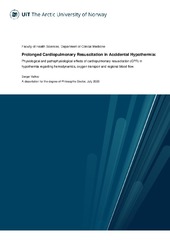Prolonged Cardiopulmonary Resuscitation in Accidental Hypothermia: Physiological and pathophysiological effects of cardiopulmonary resuscitation (CPR) in hypothermia regarding hemodynamics, oxygen transport and regional blood flow
Permanent link
https://hdl.handle.net/10037/31973Date
2023-12-21Type
Doctoral thesisDoktorgradsavhandling
Author
Valkov, SergeiAbstract
Paper 1 describes changes in hemodynamics, O2 transport, and organ blood flow during 3-h stable hypothermia (27°C) and rewarming with spontaneous circulation using thoracic lavage as a rewarming method. The results of the study indicated that despite a hypothermia-induced substantial reduction in cardiac output (CO) and mean arterial pressure (MAP), compensatory responses could provide adequate O2 delivery and blood flow distribution to essential organs after rewarming from 3 hours hypothermia (27°C)
Paper 2 describes the effects of CPR using an automated chest compression device in replacing spontaneous CO during 3 hours at 27°C vs. 45 min at normothermia by determining hemodynamics, oxygen transport, and organ blood flow. We found that the level to which CPR could replace CO and MAP does not change in hypothermia. Moreover, 3 hours CPR at 27°C could provide marginal but sufficient global oxygen delivery to sustain aerobic metabolism. In contrast, normothermic CPR for 45 min showed impaired hemodynamics, oxygen transport and organ blood flow.
Paper 3 was aimed to investigate autoregulation of cerebral blood flow and cerebral oxygen transport during 3-h hypothermic CPR at 27°C compared to spontaneous circulation at the same temperature. Potent physiological compensatory responses during 3-h CPR provided unaltered cerebral oxygen delivery as at spontaneous circulation and maintained aerobic metabolism and autoregulation of cerebral blood flow during 2h of hypothermic CPR.
Results from Paper I -III support using early and continuous CPR in accidental hypothermia patients in HCA under rescue and transport to hospitals capable of introducing specific rewarming techniques.
Has part(s)
Paper I: Valkov, S., Mohyuddin, R., Nilsen, J.H., Schanche, T., Kondratiev, T.V., Sieck, G.C. & Tveita, T. (2019). Organ blood flow and O2 transport during hypothermia (27°C) and rewarming in a pig model. Experimental Physiology, 104(1), 50–60. Also available at https://doi.org/10.1113/EP087205.
Paper II: Nilsen, J.H., Valkov, S., Mohyuddin, R., Schanche, T., Kondratiev, T.V., Naesheim, T., Sieck, G.C. & Tveita, T. (2020). Study of the Effects of 3 h of Continuous Cardiopulmonary Resuscitation at 27°C on Global Oxygen Transport and Organ Blood Flow. Frontiers in Physiology, 11:213. Also available in Munin at https://hdl.handle.net/10037/18567.
Paper III: Valkov, S., Nilsen, J.H., Mohyuddin, R., Schanche, T., Kondratiev, T., Sieck, G.C. & Tveita, T. (2022). Autoregulation of Cerebral Blood Flow During 3-h Continuous Cardiopulmonary Resuscitation at 27°C. Frontiers in Physiology, 13:925292. Also available in Munin at https://hdl.handle.net/10037/27468.
Publisher
UiT The Arctic University of NorwayUiT Norges arktiske universitet
Metadata
Show full item recordCollections
The following license file are associated with this item:


 English
English norsk
norsk
